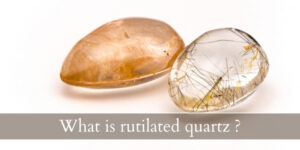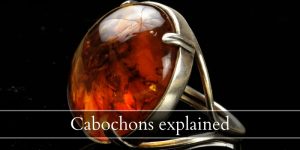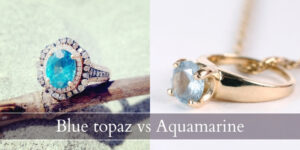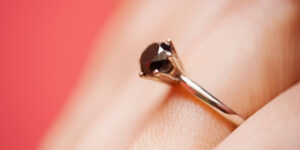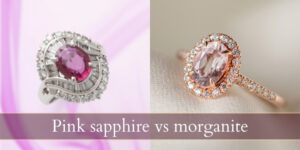When deciding your engagement ring diamond you’ve got to pay attention to so many details, and one of them is the shape and cut style of the diamond itself. This means you’ll be looking at quite a few diamonds, and possibly even trying them on. In the end, you heart might be torn between two beautiful but different pieces. So what if you have to make the difficult decision between a radiant cut and an oval cut ?
Today we’re comparing oval cut diamonds with radiant cut diamonds, and seeing their key differences and similarities. These will provide you with more info and you can make a better informed decision. We still think it’s a good idea to go and try these diamonds on your hand, but reading up on them also helps. So let’s discuss them.
Radiant cut vs oval cut diamond
Radiant cut diamonds are a more modern look, and they are also more affordable than oval diamonds. Oval diamonds are more popular as they resemble the round, but they are different enough to be viewed as alternative. The oval cut is notorious for its bow tie effect, which the radiant doesn’t usually show. A radiant can be either squares or elongated, while the round will always look elongated.
Both the oval and the radiant have plenty of sparkle, as they are both brilliant cuts. Radiants have the crushed ice effect more often than the oval cuts, because there are more cut variations. And finally, ovals face up a bit larger than radiants as they tend to be a shallower cut.
What is a radiant cut ?
The radiant cut is a rectangular cut diamond with a brilliant cut style. It’s meant to be very sparkly and perhaps the best hybrid between a brilliant cut and a rectangular shape. Radiant diamonds have a shape like the emerald cut, rectangular and usually elongated, with clipped corners but both the crown and the pavilion have a brilliant cut style.
Due to the way the facets are arranged on the pavilion it seems like they form a wheel with spokes, or a sort of perfect spider web. The very center of the radiant cut looks rounded with many facets bursting from the center. There are many variations on the radiant cut, and perhaps the most popular is the crushed ice one, with extra facets that are smaller than usual, to create a crushed ice look.
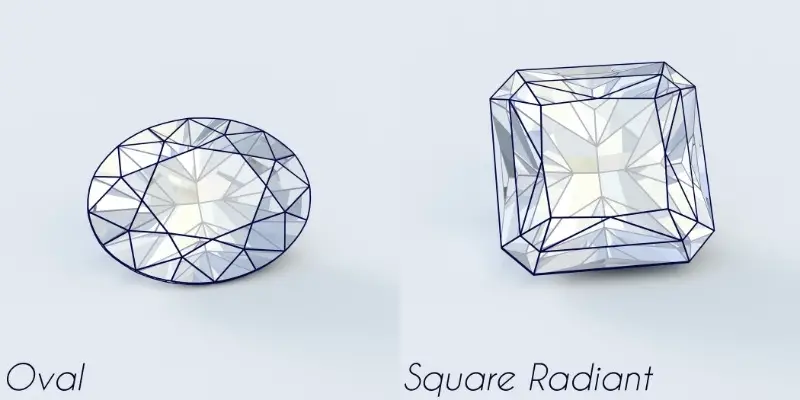
What is an oval cut ?
An oval cut diamond is another brilliant cut diamond, and it looks just like an elongated round brilliant cut, because that is pretty much what it is. The oval cut has facets just like the round cut, but the facets in the middle of the pavilion are wider, due to the extra length in an oval cut.
This cut style depends a lot on the length to width ratio in order to look great on someone’s hand, otherwise it can be too stout or too skinny and not compliment the hand and finger shape at all. Now let’s compare the radiant cut with the oval cut and see how they differ in much more detail.
1. Ovals are always elongated, radiants are both elongated and squared
Perhaps what drew you to the oval shape was its slander, elongated shape and glamorous sparkle. This diamond is truly a beauty and because it’s an elongated shape it can suit pretty much anyone. The proper L/W ratio for each person can really make an oval diamond look like it completes your hand and overall look.
The radiant cut can be both elongated and nearly square. It is never a 1:1 perfect square, rather it’s more of a 1:1.10 ratio. The elongated ones look best at about 1:1.30-1.40. That being said, if you just ask for a radiant you never know if it’s going to be elongated or not, so we recommend going with the oval if you want to be very sure you get a longer-looking diamond.
Read also: Asscher VS Cushion Cut
2. Radiant cuts are rectangular, ovals are rounded
We’ve talked about diamonds complimenting your hand and fingers, but there’s more to it than whether it’s elongated and by how much. The overall shape of the diamond matters a lot as well. Your general nail shape is a good indicator of whether you should go for a more rounded or rectangular shape.
The benefits of an oval (so rounded) are that it’s easier to wear, goes with pretty much anything, and is similar enough to the round brilliant to not cause too much of a fuss. It also goes a bit better with a more feminine style. The rectangular look is more androgynous, with a clear, sharp outline and it, too, goes with many styles but possibly not all of them.
Take a look at your other jewelry, rings, earrings, bracelets, and so on. See whether you’re more comfortable with rounded or rectangular-looking ones, more geometric shapes vs more organic shapes, and you’ll find it easier to choose between an oval and a radiant.
3. Ovals have a bow tie, radiants rarely do
An important feature of many elongated diamond is that they tend to show a bowtie – an area right in the middle of the diamond that reflects no light, and looks like a black bowtie. Some diamonds have a very subdued one, and other are immediately noticeable. It usually has to do with the angle on the facets and thus the cut quality and alignment.
Ovals are notorious for bow ties, as are marquise and pear cuts. It’s much more difficult to properly angle the facets with a rounded outline than it is for a rectangular shape.
Some elongated radiants do have a bowtie, but you will find those much less than you will find an oval with a bow tie. So overall, you have a higher chance of getting an even-looking diamond if you go for a radiant. If you’re find with a bow tie in diamonds then an oval is more likely to be your style.
4. Radiants have more of the crushed ice effect than ovals
Radiants and ovals are both brilliant cuts, but there are more variations on the radiant cut than there are on the oval cuts. One of these variations is the crushed ice effect, which is simply another cutting style that adds extra facets to the pavilion, so the overall side of all the facets is smaller, leading to even smaller sparkles. The result is similar to what you’d get in a summer cocktail full of crushed ice.
Meanwhile oval cuts also have their own crushed ice effect, most noticeable near the tips of the ovals. Though you won’t find this in all ovals and you’ll definitely find less crushed ice ovals than crushed ice radiants.
5. Ovals are more popular and expensive than radiants
Oval cut diamond seem to be a bit more popular than radiant cuts, and also more expensive. Both of them are more affordable than the round brilliant by about 30%, and way less popular. But, the oval cut’s resemblance to the round makes people a bit more comfortable with it, and actually draws more sales.
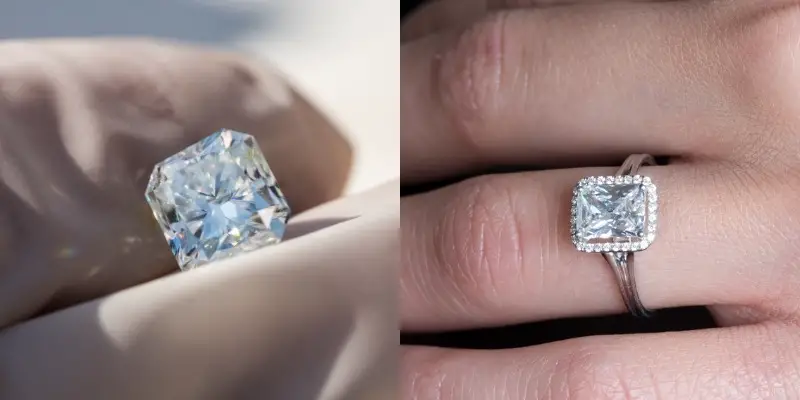
So you’ll notice when looking for the perfect oval and the perfect radiant that ovals tend to be about 10-12% more expensive than radiants, and also harder to come by. Radiants are by no means rare, not like an Asscher cut. But they’re not carried by as many jewelers as ovals or cushions or even princess cuts.
6. Radiants offer a more modern look than ovals
Perhaps because of that resemblance to a round brilliant ovals manage to look non-traditional without going too far off the beaten path, Often people want something just a little different, not an entirely new concept. And that’s fine, we’re all different and we like different things.
Radiants have that angular look about them, even with a brilliant cut. Because of this, they have a modern air to them, and definitely something you’d expect from a 2010s and onwards engagement. Even so, they’re not something you commonly see in the bridal space.
So if you’re after something that’s more modern, only traditional through its sparkle, then perhaps the radiant cut is just the right one for you. If you’re looking for something that’s not your everyday round cut, but still looks familiar, then the oval cut may be a safer choice.
7. Ovals face up a bit bigger than radiants
Radiant cuts use up more of the diamond rough than ovals. Not double the amount, but enough to make it matter when the final carat weight is calculated. Radiants are also cut a bit deeper than most ovals, so a 1.00 ct radiant will look slightly smaller than a 1.00 ct oval, simply because the oval splays more than the radiant.
If you’re on a budget and carats are the main thing you can tweak, then an oval might just save you some money.
Both ovals and radiants are brilliant cuts
Both ovals and radaints will sparkle like mad for you, because they are brilliant cuts. Whichever you choose, you can rest assured that there won’t be a dull diamond.
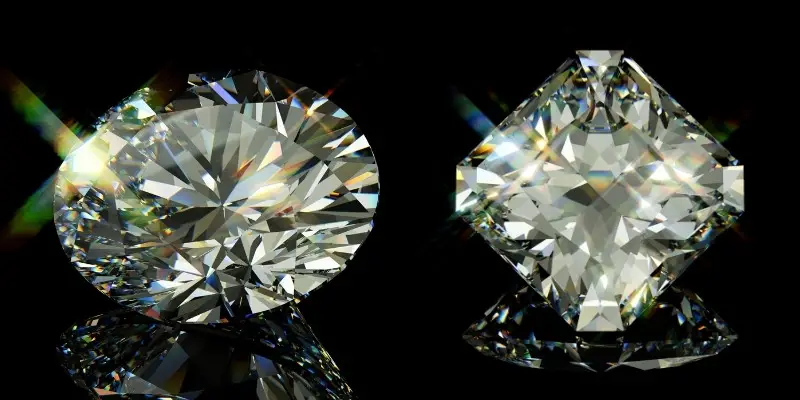
And as brilliant cuts both, you can go a little lower in color and clarity because of all those tiny facets that manage to hide most inclusions and even the first hint of color in your diamond.
Both the radiant and the oval cut need a good L/W ratio
Both the radiant and the oval have a length to width ratio you need to keep an eye on. Not all of them are made the same, and not all of them will be flattering to you. For example a slim hand with short, stubby fingers won’t look great with a tall, skinny oval or radiant. Instead a more stout one, like a 1:1.20 would be great in this case, both for a radiant and an oval.
Or, for the ones with thin, knobbly fingers a longer oval or radiant (like a 1:1.35) would look better. Really it’s all about trying different ratios and seeing which would work best with your hands.
And, if for some reason all you could find was a diamond with an off ratio, you could use whatever leftover budget you have for some side stones (to get a wider-looking ring) or some accent stones on the top to make it look a bit taller. Or, simply turn the diamond east-west and have a very modern twist !

I’m the main author for jewelrymaterialguide.com. I started this site after we did tons of research before our wedding and noticed that there is information about rings, jewelry, and so on that is really hard to find on the internet.

